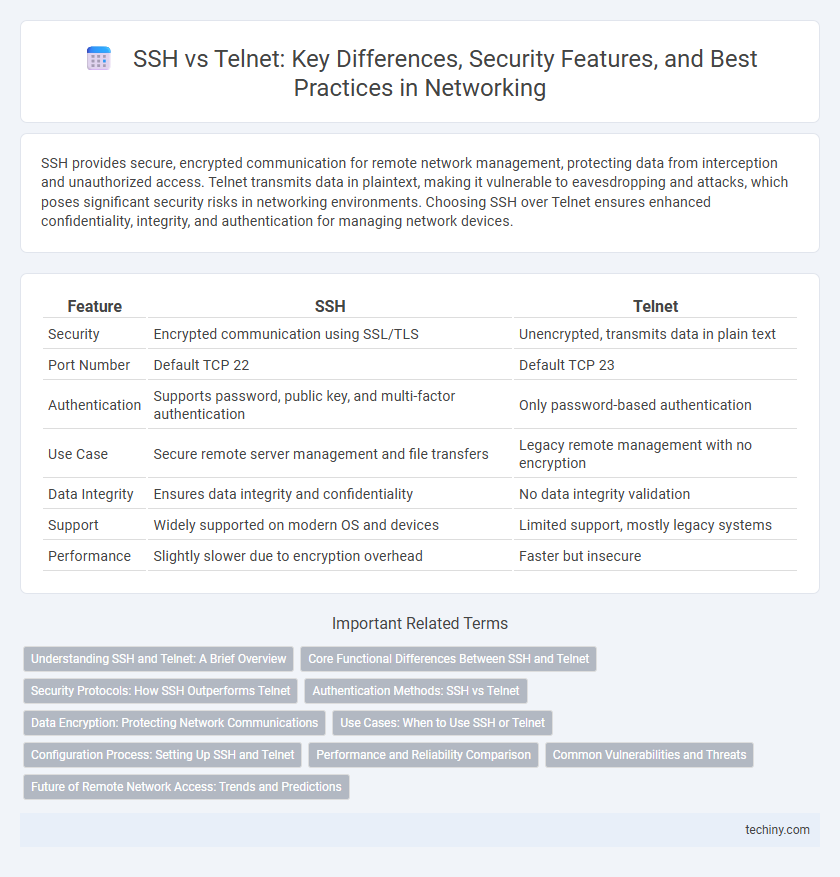SSH provides secure, encrypted communication for remote network management, protecting data from interception and unauthorized access. Telnet transmits data in plaintext, making it vulnerable to eavesdropping and attacks, which poses significant security risks in networking environments. Choosing SSH over Telnet ensures enhanced confidentiality, integrity, and authentication for managing network devices.
Table of Comparison
| Feature | SSH | Telnet |
|---|---|---|
| Security | Encrypted communication using SSL/TLS | Unencrypted, transmits data in plain text |
| Port Number | Default TCP 22 | Default TCP 23 |
| Authentication | Supports password, public key, and multi-factor authentication | Only password-based authentication |
| Use Case | Secure remote server management and file transfers | Legacy remote management with no encryption |
| Data Integrity | Ensures data integrity and confidentiality | No data integrity validation |
| Support | Widely supported on modern OS and devices | Limited support, mostly legacy systems |
| Performance | Slightly slower due to encryption overhead | Faster but insecure |
Understanding SSH and Telnet: A Brief Overview
SSH (Secure Shell) and Telnet are protocols used for remote device management, with SSH providing encrypted communication to enhance security, while Telnet transmits data in plain text, making it vulnerable to interception. SSH operates on port 22 by default and uses cryptographic techniques such as public key authentication to ensure data integrity and confidentiality. Telnet, operating on port 23, is largely deprecated due to its lack of encryption and susceptibility to eavesdropping and man-in-the-middle attacks.
Core Functional Differences Between SSH and Telnet
SSH encrypts all data exchanged between the client and server, providing secure remote access and preventing eavesdropping, while Telnet transmits data in plaintext, making it vulnerable to interception. SSH supports strong authentication methods such as public key cryptography, whereas Telnet relies on basic username and password authentication without encryption. Protocol-wise, SSH operates on port 22 and establishes a secure channel using cryptographic techniques, whereas Telnet uses port 23 and offers no built-in security mechanisms.
Security Protocols: How SSH Outperforms Telnet
SSH employs strong encryption protocols such as AES and RSA to secure data transmission, making it highly resistant to eavesdropping and man-in-the-middle attacks, unlike Telnet which sends data, including passwords, in plaintext. SSH supports secure authentication mechanisms including public key authentication and multi-factor authentication, vastly enhancing access control compared to Telnet's basic username and password verification. As a result, SSH is widely adopted in secure network management, protecting sensitive information across untrusted networks.
Authentication Methods: SSH vs Telnet
SSH employs robust authentication methods such as public key cryptography, password authentication, and two-factor authentication to ensure secure access. Telnet relies primarily on plaintext password authentication, making it highly vulnerable to interception and unauthorized access. Secure Shell (SSH) encrypts authentication credentials, whereas Telnet transmits them in clear text, posing significant security risks.
Data Encryption: Protecting Network Communications
SSH employs robust data encryption algorithms such as AES and RSA, ensuring that all transmitted information remains confidential and secure from interception or tampering. Telnet transmits data in plaintext, exposing sensitive credentials and commands to potential eavesdroppers and cyberattacks. Encrypting network communications with SSH significantly reduces the risk of unauthorized access and enhances overall network security.
Use Cases: When to Use SSH or Telnet
SSH is the preferred protocol for secure remote access to network devices, system administration, and encrypted file transfers, ensuring protection against eavesdropping and cyber attacks. Telnet is suitable primarily for accessing legacy systems or devices within trusted, isolated environments where security is not a concern. Use SSH for any situation requiring authentication and data confidentiality, reserving Telnet only for basic, non-sensitive troubleshooting on secure internal networks.
Configuration Process: Setting Up SSH and Telnet
Configuring SSH requires generating cryptographic keys and enabling SSH service on network devices to ensure encrypted remote access. Telnet setup involves simply activating the Telnet protocol and assigning user credentials without encryption features. SSH configuration also includes specifying access control lists (ACLs) and defining secure authentication methods like public key authentication, which Telnet lacks.
Performance and Reliability Comparison
SSH offers superior performance and reliability compared to Telnet by encrypting data transmission, which prevents eavesdropping and man-in-the-middle attacks common in Telnet sessions. SSH uses stronger authentication mechanisms like public key cryptography, reducing the risk of unauthorized access and connection interruptions. The protocol's robustness ensures stable connections over unreliable networks, whereas Telnet's lack of encryption and weaker authentication often results in slower, less secure, and less reliable sessions.
Common Vulnerabilities and Threats
SSH and Telnet differ significantly in security, with Telnet transmitting data, including passwords, in plaintext, making it highly vulnerable to interception and eavesdropping attacks. SSH uses strong encryption algorithms like AES and RSA, providing confidentiality and integrity to protect against man-in-the-middle and replay attacks. Telnet's lack of encryption exposes networks to credential theft and session hijacking, whereas SSH mitigates these threats through robust authentication methods such as public key cryptography and secure channel establishment.
Future of Remote Network Access: Trends and Predictions
SSH is rapidly becoming the dominant protocol for remote network access due to its robust encryption and authentication mechanisms, addressing the increasing cybersecurity demands of modern infrastructures. Telnet's lack of security features and vulnerability to interception render it obsolete in enterprise environments, leading to its gradual phase-out in favor of more secure alternatives. Emerging trends emphasize the integration of SSH with multi-factor authentication and automated key management to enhance access control and operational efficiency in cloud and IoT network environments.
SSH vs Telnet Infographic

 techiny.com
techiny.com